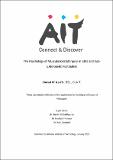| dc.contributor.advisor | Ní Chéilleachair, Niamh | |
| dc.contributor.advisor | O'Connor, Siobhán | |
| dc.contributor.advisor | Campbell, Mark | |
| dc.contributor.author | O'Keeffe, Sinéad | |
| dc.date.accessioned | 2022-07-07T09:06:56Z | |
| dc.date.available | 2022-07-07T09:06:56Z | |
| dc.date.copyright | 2021 | |
| dc.date.issued | 2021-01 | |
| dc.identifier.citation | O'Keeffe, S. (2021).The psychology of musculoskeletal injury in elite and sub-elite Gaelic footballers. Thesis (Doctor of Philosophy (PhD). Athlone Institute of Technology | en_US |
| dc.identifier.uri | http://research.thea.ie/handle/20.500.12065/4021 | |
| dc.description.abstract | Background: Gaelic football participation is associated with an inherent risk of musculoskeletal injury eliciting physical and psychological consequences. However, there is a current dearth of awareness of the psychology of injury in adolescent and adult Gaelic footballers.
Aim: This research aimed to (i) examine the epidemiology of and psychological response to musculoskeletal injury in male adolescent Gaelic footballers and its association with load, (ii) identify the perceived barriers and facilitators to mental health help-seeking in elite and sub-elite Gaelic footballers post-injury and (iii) design and implement a novel mental health literacy (MHL) educational intervention programme in Gaelic footballers.
Methods: Injuries, defined as any injury sustained during training or competition causing restricted performance or time loss from play, were assessed and recorded weekly. Written training diaries examined weekly exposure and the duration and intensity of each activity. Fear-avoidance and psychological readiness to return to play were quantitatively examined in adolescent Gaelic footballers who sustained an injury. Qualitative focus groups identified the barriers and facilitators to help-seeking in elite and sub-elite adult Gaelic footballers. A novel MHL educational intervention programme was designed and implemented in Gaelic footballers.
Results: One fifth of male adolescents experienced an injury during the season with acute, lower extremity injuries most common. Weekly load, monotony and absolute change in load were significant injury risk factors. Fear-avoidance was evident post-injury and was higher in those with greater pain scores. Education, attitudes to help-seeking, the attitudes and actions of others and accessibility were identified as key barriers and facilitators in elite and sub-elite Gaelic footballers. A MHL educational intervention programme effectively reduced stigma, improved attitudes to help-seeking and increased recognition and knowledge of mental health issues.
Conclusion: Effective injury prevention, recognition of the importance of psychological rehabilitation and successful monitoring and open communication in reducing applied loads are necessary to reduce the risks and effects of injury in male adolescent Gaelic footballers. Given the potential mental health issues that can accompany injury, rehabilitation of injured athletes must consider the facilitation and encouragement of help-seeking among players. Educational MHL interventions may be effective for facilitating mental health help-seeking post-injury. | en_US |
| dc.format | PDF | en_US |
| dc.language.iso | eng | en_US |
| dc.publisher | Athlone Institute of Technology | en_US |
| dc.rights | Attribution-Non-Commercial-Share-Alike-4.0 International | * |
| dc.rights.uri | http://creativecommons.org/licenses/by-nc-sa/4.0/ | * |
| dc.subject | Musculoskeletal injury | en_US |
| dc.subject | Gaelic football injuries | en_US |
| dc.title | The psychology of musculoskeletal injury in elite and sub-elite Gaelic footballers | en_US |
| dc.type | info:eu-repo/semantics/doctoralThesis | en_US |
| dc.contributor.affiliation | Athlone Institute of Technology | en_US |
| dc.identifier.orcid | https://orcid.org/ 0000-0003-3077-1044 | en_US |
| dc.rights.accessrights | info:eu-repo/semantics/openAccess | en_US |
| dc.subject.department | Faculty of Science & Health AIT | en_US |


